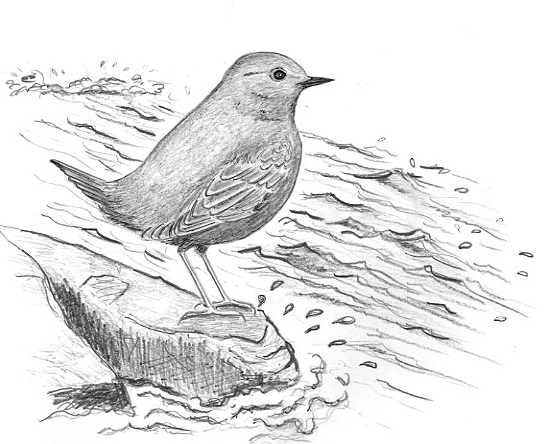
Dear Bird Folks,
I hope to see an American Dipper some day. Just reading about this fascinating bird makes me want to go out and find one. I also read that it is sometimes called the “Water Ouzel.” I’ve never heard that term before. Do you have any idea where the name “ouzel” comes from? It sounds kind of creepy to me.
– Stella, Charleston, SC
I’m with you, Stella,
“Fascinating” is a perfect adjective for a dipper. There is no other bird quite like it. I also agree about the “ouzel” thing. It is a creepy name. The word ouzel sounds more like an infected toe than an interesting bird. I don’t even like saying ouzel. It makes my face get all weird like I’ve just eaten a bad grapefruit. Try this: Look in the mirror and say “ouzel.” See what I mean?
It would be hard to imagine an odder bird than the American Dipper. It’s your basic combo-special. It has the gray coloring of a catbird, the body shape of a wren, and it behaves like a duck. The Australians are always bragging about how cool their own combo-special, the platypus, is, but the dipper can do everything a platypus can, plus it can fly. Ha, in your face, Aussies.
Dippers are the only songbirds that hunt for food by diving underwater. They live along rushing, mountain streams. When they get hungry they simply dive into the water, walk along the streambed, and look for food. They will also chase after small fish and aquatic insects by “flying” underwater, using their wings for propulsion. Remember, dippers are songbirds. Unlike ducks, they don’t have powerful webbed feet to push them through the water, so they use their wings.
Stream is the key word when talking about dippers. Cold mountain streams produce the food that dippers depend on. Are there any cold mountain streams around Charleston, Stella? You might want to check into that before you go looking for your first dipper. I’d hate for you to be disappointed. Actually, not only do you need to find a cold stream, but you will also have to do a bit of traveling. American Dippers are restricted to the western part of North America. They are found in Alaska’s Brooks Range, the Cascades, the Rocky Mountains, and on Frontierland’s Big Thunder Mountain…but only when they are on vacation.
These streams not only provide the bird with food, but they also supply it with its nesting habitat. Their mossy, dome-shaped nests are typically found under rock ledges that hang over water. This helps protect the babies from predators. For even better protection the birds will sometimes build a nest directly behind a waterfall. This may be an obstacle for predators but not for the dippers.
They simply fly directly through the falling water to get to their nest. And because the mossy outer part of the nest is kept damp by the constant splashing, the moss will actually continue to grow even while its part of the nest (a Chia nest if you will).
You might think that a dipper gets its name because it’s always going for a “dip,” but the name comes from the bird’s behavior when it’s on land. When a dipper is not in the water it is on the water’s edge, staring at it. While it stares at the water the bird’s body bobs up and down in a constant “dipping” motion. It looks like a little kid who is trying to get up enough nerve to jump into a swimming pool for the first time. Of course the dipper has no fear of water, so why the constant dipping? Well, the dippers aren’t saying, but many experts think it has to do with communication. This is a songbird that lives in a very noisy environment. The waterfalls and rushing streams continuously drown out the bird’s song. In order to make its feelings known, the bird uses body language. The more upset or agitated the bird becomes the more it dips. I’m going to have to try dipping the next time I’m stuck in line at the airport. I’ll bet the TSA will love that.
The American Dipper has one other odd feature that it may or may not use for communication, but it’s certainly an attention getter. As I mentioned earlier dippers are solid dark gray in color. However, they have these freaky white feathers on their eyelids. When the dark-eyed birds blink, their eyes instantly become white, making them look very zombie-ish or as if they’ve gotten ahold of some bad mascara.
Since the North American bird is called the “American” Dipper, you might think that there are dippers elsewhere in the world, and you would be correct. The European Dipper is the one that started this ouzel thing. The word ouzel sounds to me like it should be French, but it’s actually English. Early birders mistakenly thought dippers were blackbirds; ouzel is derived from “osle,” the old English word for blackbird. Exciting stuff, eh?
You should plan a trip out West to see dippers, Stella. These duck wanna-be’s are fun birds to watch. In the meantime you could practice saying ouzel in front of a mirror. It may not be as exciting as watching a real dipper, but it will keep everyone else around you entertained for hours.